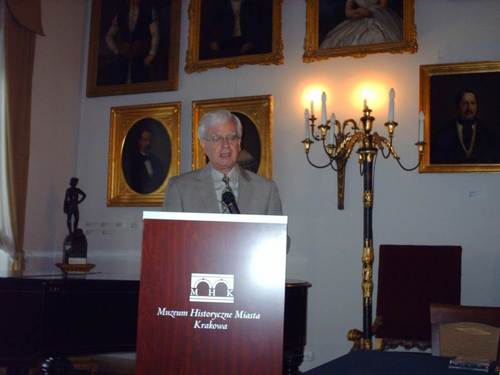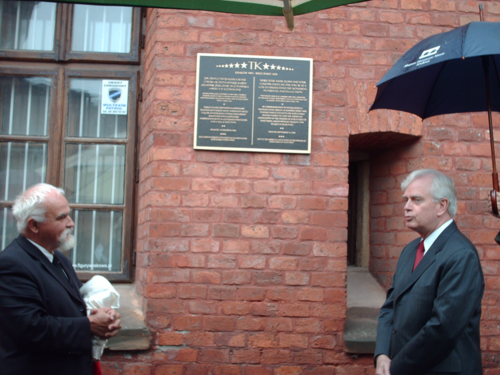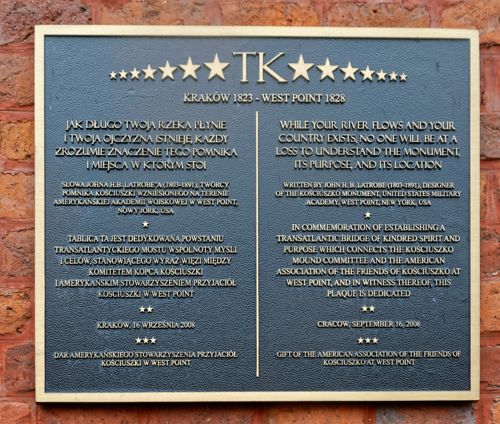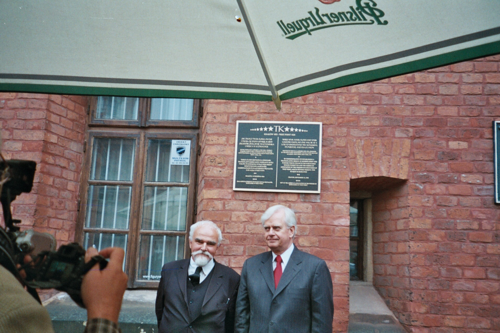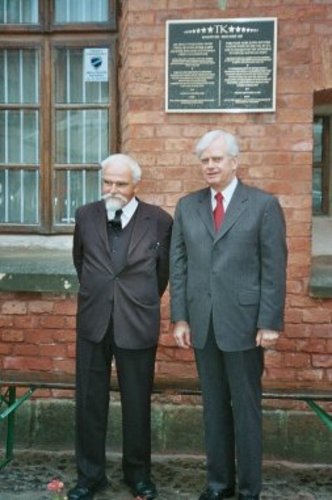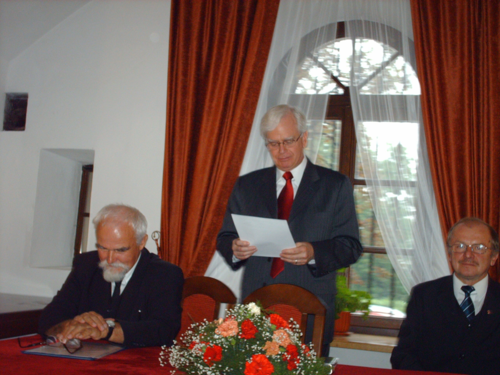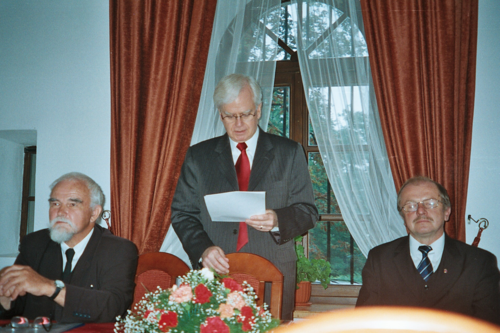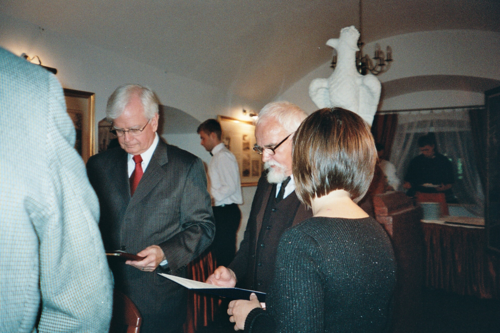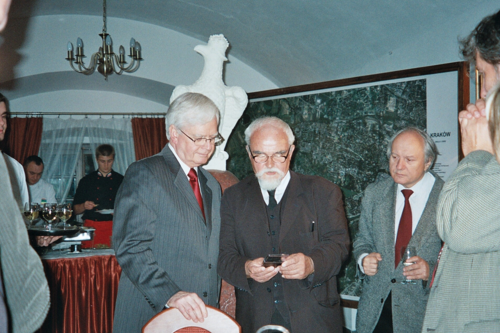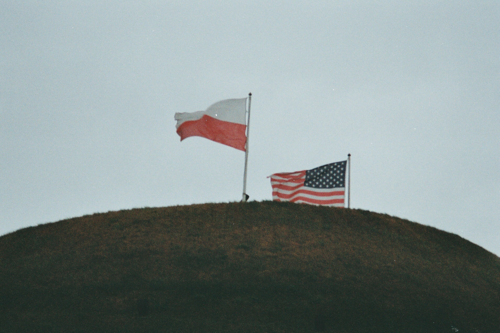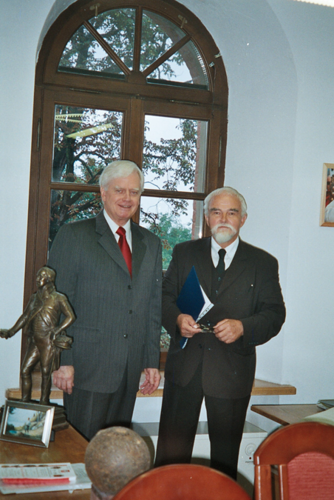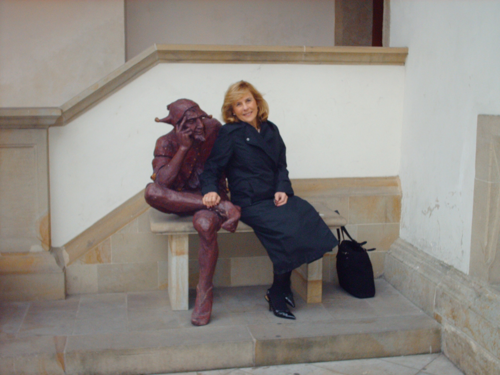

Highlights and Other News (2018)
Conference / Observance (2019)
USMA Kosciuszko Monument at Age 195
|
An exceptional scheduled opportunity had been extended to Dean Bajdek by the Kosciuszko Mound Committee to deliver an address in Polish on his subject, "West Point i Swiecka Swietosc Tadeusza Kosciuszki we Wczesnej Republice Amerykanskiej" (West Point and the Secular Sainthood of Thaddeus Kosciuszko in the Early American Republic) on September 15, 2008 in the Museum of the Historical City of Krakow. He opened his presentation with the statement: "Transcending time and distance as well as language, history, and cultural tradition, two remarkable events -- the completion of the Kosciuszko Mound in Krakow in 1823 and the completion of the Kosciuszko Monument in West Point in 1828 -- continue to influence the legacy of Kosciuszko in Poland and in America to this day. Each event had been a glorious manifestation of the love for and admiration of the altruistic and courageous life of Tadeusz Kosciuszko, Polish and American patriot and hero, and champion of freedom, independence, democrary, and equality. Both events began the process of sustaining the memory of Kosciuszko by way of annual comemorations and other memorials designed to inspire Poles and Americans, particularly over successive generations upon whom the torch of leadership and civi-minded virtue would and must pass. Kosciuszko, therefore, became over time more than an historical figure. He has become a wholesome role model of compassionate, competent, courageous, and unselfish leadership for the ages, standing in sharp contrast over time to many leaders in all levels of society who often had been and unfortunately continue to be devoid of the highest personal integrity in public life and service." |
|
|
|
|
| Because of the anticipated heavy rain, extensive dedicatory remarks were re-scheduled for inclusion with the planned indoor luncheon. Umbrellas opened up by some while other members of the audience sought safety under a under a large canopy, and no time was wasted after the unveiling so that all concerned could venture indoors to the welcome warmth and cozy, well-appointed ambiance of the integral Museum, and its banquet area, of the Mound complex. For more about the history of the Kosciuszko Mound itself, visit our Contact and Link page for access to the Mound's website (www.kopieckosciuszki.pl). |
|
| The inclusion of 14 stars -- 7 in receding magnitude flanking the initials of Tadeusz Kosciuszko -- was designed by Dean Bajdek to remind all informed viewers that had it not been for Kosciuszko having participated in a pivotal way (e.g., in his design of defenses at Saratoga - Bemis Heights, on one hand, and his subsequent design of West Point's fortifications, on the other, which precluded British control of the Hudson River), the possibility of expanding the number of the original 13 rebellious colonies into a victorious and unified nation, adding a 14th and progressively 36 more United States over time would have never occurred in world history. The plaque was designed in Massachusetts, forged in Minnesota, and shipped to Krakow, Poland from Massachusetts in advance of Dean Bajdek and his wife, Cynthia, traveling to Krakow. Apart from some initial difficulty in being cleared by Polish customs officials in Warsaw, the intervention of Professor Mieczyslaw Rokosz and his assistant, Leszek Cierpialowski in Krakow, in consultation with Dean Bajdek in the United States, managed to have the very heavy plaque that was shipped in a wooden crate, to finally be cleared by Warsaw customs officials and sent on its way to the Kosciuszko Mound in Krakow, to everyone's relief. |
|
| Despite what turned out to be a day of occasional lengthy torrential rain in Krakow which began for concerned principals with a wreath-laying service at the sarcophagus of Kosciuszko in Saint Leonard's crypt of Wawel Cathedral, Heaven allowed brief respites during which photo opportunities could occur to document the events associated with unveiling the plaque. |
|
| Indeed, it had been memorable occasion never to be forgotten. |
|
| "One man, two continents, two nations, two democracies, two monuments, two rivers, and two organizations. Such are the considerations that bring us together on this beautiful September day in Krakow. We gather here, accordingly, both to commemorate the establishment of a transatlantic bridge of kindred spirit and purpose that connects the Kosciuszko Mound Committee and the American Association of the Friends of Kosciuszko at West Point, and as well, to honor Tadeusz Kosciuszko. The basis of this connection is a little known historical equation established in the early 19th century -- one aspect of which having been the completion of the Kosciuszko Mound in Krakow in 1823 and the other having been the completion of the Kosciuszko Monument of West Point in 1828 -- wherein the piles upon which the structure of today's transatlantic bridge would rest -- driven firmly into the soil and fabric of Poland and into the soil and fabric of the United States of America." These had been the opening dedicatory remarks of Dean Bajdek that preceded a delicious luncheon in a convivial atmosphere for some thirty invited guests that was held in the Museum of the Kosciuszko Mound complex. Please note that outdoors the sky appeared to be clearing up. |
|
| He went on also to state: "Remember also that West Point surprisingly would not erect a magnificent equestrian monument to George Washington until 1916, some 88 years following the erection of its Monument to Kosciuszko -- not because Americans revered Washington less than they revered Kosciuszko -- for the United States erected many monuments nationwide to honor Washington's memory, not the least of which was to name the nation's capital after him. The Kosciuszko-related actions of 1825 to 1828 at West Point served as an uninteded practical demonstrationof the strength of the purely American fervor in those days for perpetuating Kosciuszko's memory at West Point. Ponder that reality well, for in it rests ther perpetual glory of Kosciuszko, who was and will always continue to be a credit to his parents, his Polish upbringing, his integrity, his Chrsitianity, his Enlightenment ideals, his unwavering sense of social justice and equality for -- and God-given dignity of -- all men and women, his love for Poland, and his love for America." Please note that within minutes, however, the sky began darkening once again. |
|
| In awarding the Committee's Kosciuszko Medal to Dean Bajdek, Professor Mieczyslaw Rokosz, Ph.D., stated that the obverse side of the medal "was prepared by a notable member of our Committee, a great artist and sculptor, Professor Czeslaw Dzwigaj.... It bears the image of Kosciuszko, and is an exact replica of the medal designed by Cannai and [sculpted] by Durand in Paris immediately after the Hero's death. The reverse [side]..., much like the plaque funded by [your Association], is meant to commemorate our meeting on September 16, 2008, during which two flags, Polish and American, flew over Kosciuszko's Mound, and which established an arch of a transatlantic bridge of [common] goals and ideals between the Committee and the Association.... This community of goals and ideals rises in turn from the humanistic strands of Greco-Roman and Judeo-Christian traditions, which are the common source of the euroatlantic culture, from which emanates the spirit of Kosciuszko, who belongs to the whole world, and whose virtues are the virtues of Mankind." |
|
| Professor Rokosz went on to say that the medal was cast in bronze with the aforesaid early 19th century image of Kosciuszko by Canoi and Durand in Paris and replicated in 2008 by Dzwigaj in Krakow on the obverse side, and on the reverse side, inscribed in Polish along the outer perimeter: "Krakow 1823, West Point 1828, M. Rokosz, A. Bajdek, Prezesi" and in the inner perimeter, "Amer. Stow. Przyjaciol Kosciuszki w West Point, Komitet Kopca Kosciuszki w Krakowie, Krakow, 14 - 16 IX AD 2008." A propos the weather, please note the now-blackened sky of early afternoon that marked the coming of yet another heavy downpour of cold rain. |
|
| And here Professor Rokosz prepares to present the Kosciuszko Medal to Dean Bajdek on behalf of the venerable Kosciuszko Mound Committee. With nature taking its inevitable course outdoors, it was wonderful to be warm, dry, and exceptionally well-fed indoors. |
|
| "I am familiar with your Committee's gracious practice to display the flag of the United States of America every Fourth of July in honor of America's Independence for which Kosciuszko fought and shed his blood. However, from this day on, dear citizens of Krakow, remember as well the Fourth of July as the day in America that the world's second oldest Monument to Kosciuszko after your own of 1823, was unveiled in 1828. Therefore, I submit for your consideration that the flag of the United States has yet a second compelling reason for being displayed atop the Kosciuszko Mound every Fourth of July and should be remembered as such by all 'friends' of Kosciuszko in Poland." Excerpt taken from the plaque dedication presentation by Anthony J. Bajdek on September 16, 2008. |
|
| Dean Bajdek met with Professor Rokosz in his office following all of the day's activities at the Kosciuszko Mound. It had been a long day indeed, beginning with the wreath-laying ceremony at the sarcophagus of Kosciuszko in Wawel Cathedral during which Dean Bajdek recited appropriate prayerful excerpts in Polish from the poem, "Modlitwy Pielgrzyma" (Prayers of the Pilgrim) written by Adam Mickiewicz (1798-1855), Poland's greatest 19th century Romantic poet, in which Mickiewicz invoked: "God of the Jagiellonians! God of the Sobieskis! God of the Kosciuszkos! Be merciful upon our Fatherland, and upon us" (Boze Jagiellonow! Boze Sobieskich! Boze Kosciuszkow! Zlituj sie nad Ojczyzna nasza, i nad nami," (Jagiellonian kings, King Jan Sobieski, and Tadeusz Kosciuszko all having been interred in Wawel Cathedral) after which Professor Rokosz led Dean Bajdek and his wife on a private tour of Wawel Castle. After completing the tour, their party departed from Wawel Castle, being driven across the bridge to the opposite shore of the Vistula (Wisla) River to reach the Kosciuszko Mound complex located on Blessed Bronislawa Hill (also known as the Sikornik). Needless to say, the day's unpleasant weather finally came to an end as well. |
|
| All but one of the photos appearing in "Retrospect (2008)" had been the product of the Association's Treasurer / Secretary, Cynthia J. Bajdek, who on the occasion of being in Krakow with her husband for the ceremonies related to the dedication of the plaque described above, also served ably as the ever-resourceful photographer-in-chief. |
|
| "When Latrobe submitted his design of the Kosciuszko Monument for the consideration of the Corps of Cadets in his letter of March 25, 1825, he recommended that the name KOSCIUSZKO should simply be inscribed on it. Whereas some Cadets had hoped that more about Kosciuszko's life would be inscribed on the Monument, Latrobe thought differently -- for after all, Kosciuszko was held to be the secular patron saint of West Point -- and consequently Latrobe added to his letter, the definitive statement: 'While your River flows and your Country exists, no one will be at a loss to understand the Monument, its purpose, and its location.' Little did Latrobe know on March 25, 1825, that his straightforward, beautifully-structured, and thorouglly-evocative words would be spoken here in Krakow some 183 years later on September 16, 2008. His words, though written with reference to the Kosciuszko Monument overlooking the Hudson River in my Republic of the United States of America, are remarkably and equally applicable, I propose, to the Kosciuszko Mound overlooking the Vistula River in your Republic of Poland," Bajdek ended.
FINAL NOTE: Robert E. Lee (1807-1870), iconic West Point graduate, United States Army general, West Point superintendent, and later Confederate States of America general, had been a member of the Cadet Committee that John H. B. Latrobe (1803-1891) had written to on March 25, 1825. To many American historians and students of the Civil War, the most authoritative and complete biography of Robert E. Lee is the 1934 four volume, "R. E. Lee: a Biography," written by Douglas Southall Freeman. In Volume 1, Chapter IV ("The Education of a Cadet"), page 70 , Freeman states very clearly that "Kosciuszko was in those days the patron saint of West Point." |
|
